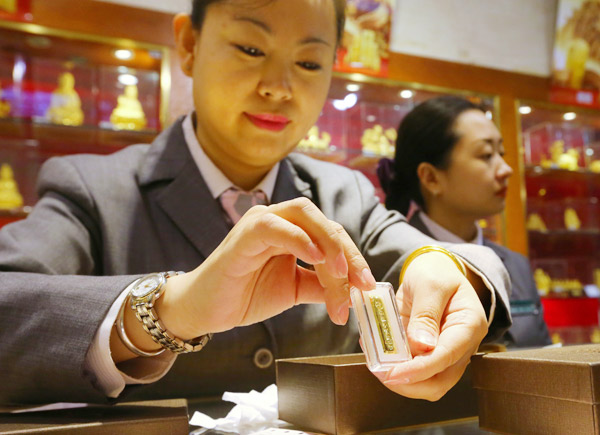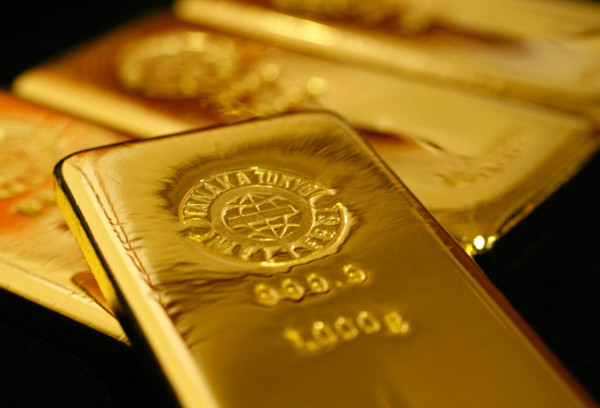


A worker displays a gold bar at a department store in Beijing. JIANG DONG / FOR CHINA DAILY
China's demand for gold bars and coins soared 30 percent year-on-year to 105.9 metric tons in the first quarter of this year, the fourth strongest quarter on record, according to a report released by the World Gold Council on Thursday.
Overall demand for gold in the Chinese market grew 8 percent year-on-year to 282.4 tons, making China the world's top gold consumer, according to WGC data.
Global demand for gold in the quarter was 1,034.5 tons, an 18 percent year-on-year decrease from the record high level recorded for the first quarter of 2016.
Analysts said demand for bullion was often adjusted in alignment with the overall economic picture.
In the Chinese market, investors wishing to preserve value and hedge their risks amid market uncertainty and currency volatility have driven demand for gold, according to the WGC report.
"Investors, particularly individual investors, who wish to diversify their portfolio because of concern about the outlook for real estate and stock market, are having more interest in gold," said Roland Wang, WGC China managing director.
For a similar reason, gold ETFs in China are also getting increasingly popular among institutional investors who are re-recognizing gold as a tool for risk hedging when they are no longer focusing only on yield and allocating more resources on risk management, said Wang.

(Photo/Xinhua)
Strong demand for gold and limited growth of supply, he said, had caused an imbalance, which had led to a high premium in China over the global spot price.
That premium in the Chinese market averaged around $4 per ounce over the global spot price in recent years, but shot up to an average of $17 per ounce at the end of 2016. The WGC research found that it persisted in the first quarter this year at average of $14.2 per ounce amid limited imports and a gap between supply and demand.
China Gold Association data showed that China's output of gold in the quarter was 101.2 tons, a 9.29 percent year-on-year decline, while consumption excluding exports and investments grew 14.73 percent year-on-year to 304.1 tons.
Commercial banks, for example, have launched interest-bearing, online-tradable gold products with a minimum entry point of 1 gram, which also enables investors to withdraw physical gold through their bank networks.
"Fintech companies are also tapping into gold-backed products that reach young investors, which effectively popularizes gold-an investment conventionally believed to be a favored investment tool for senior-age investors," said a research note from Sinolink Securities Co.
The Shanghai Gold Exchange continued to gain market share, as high-net-worth individuals increasingly buy one-kilogram gold bars using the exchange's services at low margins.
The WGC said it expects China's demand for gold in 2017 to be between 900 tons and 1,000 tons. The world's second-biggest gold consumer India is expected to demand gold of 650 tons to 750 tons in 2017.
 Fire brigade in Shanghai holds group wedding
Fire brigade in Shanghai holds group wedding Tourists enjoy ice sculptures in Datan Town, north China
Tourists enjoy ice sculptures in Datan Town, north China Sunset scenery of Dayan Pagoda in Xi'an
Sunset scenery of Dayan Pagoda in Xi'an Tourists have fun at scenic spot in Nanlong Town, NW China
Tourists have fun at scenic spot in Nanlong Town, NW China Harbin attracts tourists by making best use of ice in winter
Harbin attracts tourists by making best use of ice in winter In pics: FIS Alpine Ski Women's World Cup Slalom
In pics: FIS Alpine Ski Women's World Cup Slalom Black-necked cranes rest at reservoir in Lhunzhub County, Lhasa
Black-necked cranes rest at reservoir in Lhunzhub County, Lhasa China's FAST telescope will be available to foreign scientists in April
China's FAST telescope will be available to foreign scientists in April "She power" plays indispensable role in poverty alleviation
"She power" plays indispensable role in poverty alleviation Top 10 world news events of People's Daily in 2020
Top 10 world news events of People's Daily in 2020 Top 10 China news events of People's Daily in 2020
Top 10 China news events of People's Daily in 2020 Top 10 media buzzwords of 2020
Top 10 media buzzwords of 2020 Year-ender:10 major tourism stories of 2020
Year-ender:10 major tourism stories of 2020 No interference in Venezuelan issues
No interference in Venezuelan issues
 Biz prepares for trade spat
Biz prepares for trade spat
 Broadcasting Continent
Broadcasting Continent Australia wins Chinese CEOs as US loses
Australia wins Chinese CEOs as US loses